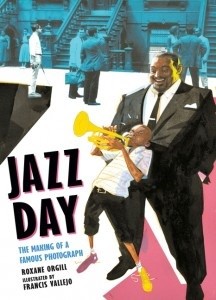2018 School Spending Survey Report
Jazz Day: Author Roxane Orgill’s 2016 BGHB Picture Book Award Speech
When I’m asked how this book came to be, I usually say that I was at a party and a woman I hadn’t met before, a person in children’s book publishing, said, “Someone should write a book about the famous Harlem jazz photograph.
 When I’m asked how this book came to be, I usually say that I was at a party and a woman I hadn’t met before, a person in children’s book publishing, said, “Someone should write a book about the famous Harlem jazz photograph.”
When I’m asked how this book came to be, I usually say that I was at a party and a woman I hadn’t met before, a person in children’s book publishing, said, “Someone should write a book about the famous Harlem jazz photograph.”That’s true. But it’s not the whole story. Jazz Day began much earlier. I was working as a music critic in the 1980s for the Bergen County Record, writing reviews, features, and news stories about classical music. One Monday, the features editor called me into her office and said I was going to be covering — in addition to classical music — jazz and cabaret, starting that very week. For no extra pay, of course, and with no concern as to whether or not I knew anything about jazz or cabaret.
Cabaret was booming in New York, but I knew so little that when I went to review Dixie Carter in her cabaret debut at the Café Carlyle that Thursday, I thought the song “Cheek to Cheek” was called “Heaven,” as in: “Heaven, I’m in heaven…” Luckily, I ran that one by the theater critic before deadline, and he gently, diplomatically, supplied the correct title for the song.
As to jazz, I was slightly better situated. I had recently taken a really good jazz history course at the New School, just for fun. Around that time I came across the famous jazz photograph, which led me to the excellent documentary about its making, A Great Day in Harlem, and the book The Great Jazz Day, yet another chronicle of the photo shoot.
So that’s how, at that party, when the publishing person suggested a book about the famous jazz photo, I knew what she was talking about. I even remembered the row of kids in the picture sitting in front, which signaled to me that perhaps this rather adult-seeming subject could be a book for children.
But what kind of book? I tried a fictional picture book story, and found out that one had already been published. I tried straight nonfiction — dull. I even toyed with a novel, very briefly. All the while I was researching: Esquire magazine, where the photo was first published; jazz in the 1950s; the photographer, Art Kane, who became a successful fashion photographer. I was attracted to the serendipity of the situation: how Kane, then a graphic designer, threw out this idea to Esquire, even though he had only taken a few photographs in his life; how Kane didn’t know if anyone would show up for the photo shoot; the unmanageability of the crowd once people did show up. And a poem popped out, or a kind of poem. I had never written poetry. I’ve always been a reader, including some poetry. But writing it? No.
I discovered that a poem allowed me to zero in like a photographer with a zoom lens on a single musician or event, for instance the kid taking Count Basie’s hat and running off. I liked the intensity and the specificity. I did attend a weekend writers’ retreat taught by the fine poet Lesléa Newman. That was my training, so-called, in poetry — that, and reading (I subscribed to the wonderful email services “Poem-a-Day” and “The Writer’s Almanac”). I admit to preferring poems I can grasp in one or two readings. Not James Merrill, but Mary Oliver, Ted Kooser.
Mostly I wrote, and I looked at the photograph. I listened to jazz in a specific way: music by some of the fifty-seven musicians in the picture, and only from that period, or earlier.
I still wasn’t sure if I was writing for children or adults, or if what I was writing was a book.
After more than a year, I sent five poems to Candlewick editor Hilary Van Dusen, to see if she might be interested. She asked if I had more (always a good sign!). I still had to make what eventually became twenty-one poems into a book, but Hilary knew how to do that. And creative director Chris Paul came up with the brilliant idea of a gatefold to display the photographic image.
Along the way, I was able to interview Kane’s son Jonathan. When he and his wife read the finished book, they cried. I don’t usually write to please people, but that made me feel good.
As does this book and the process of making it. The serendipity of it all.
From the January/February 2017 issue of The Horn Book Magazine. Read Jazz Day illustrator Francis Vallejo's speech here. For more on the 2016 Boston Globe-Horn Book Awards, click on the tag BGHB16.
RECOMMENDED
ALREADY A SUBSCRIBER? LOG IN
We are currently offering this content for free. Sign up now to activate your personal profile, where you can save articles for future viewing.







Add Comment :-
Be the first reader to comment.
Comment Policy:
Comment should not be empty !!!